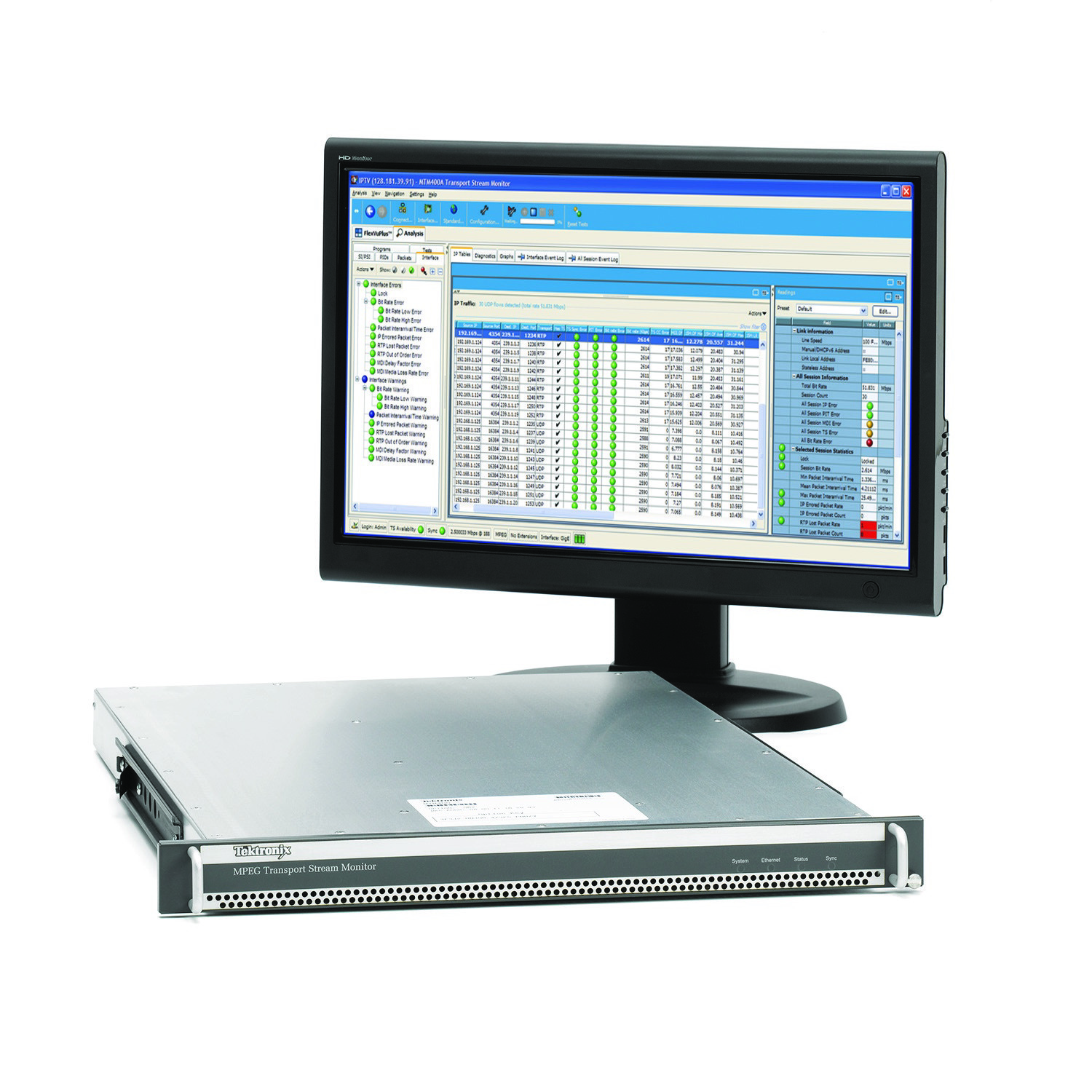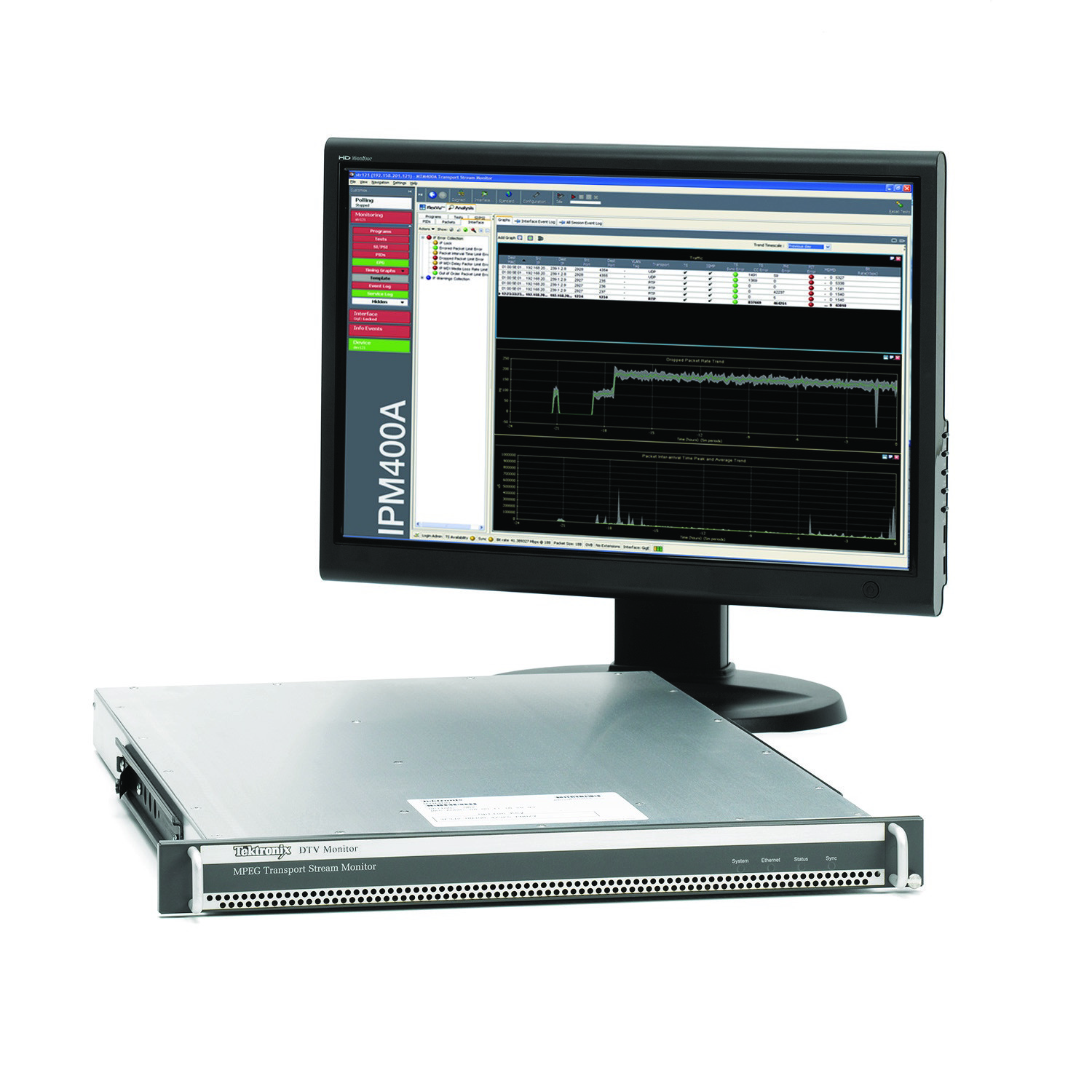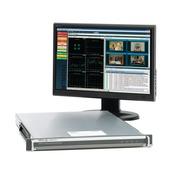Tektronix IPM400A MPEG Transport Stream Monitor
IPM400A
Product specifications
| SKU | TEL-IPM400A |
|---|---|
| Brand | Telestream |
Documentation
Please use the icons below to download any files related to this item. We aim to have the datasheet and/or catalog available.
Description
IPM400A MPEG Analyzer
MPEG Signal Diagnostics & Troubleshooting
Tektronix MPEG Analysis Instruments are the industry standard for MPEG stream analysis and interoperability testing. A key part of delivering a quality experience is finding the root cause of problems in the transport stream. Tektronix MPEG Analyzer Software allows you to go as deep as you need into the transport, PES and elementary streams to track down sources of picture anomalies or Transport Streams with errored syntax. The ability to capture events for deep analysis is critical to identifying the root cause of problems, and our QoE software analysis tools shorten the time to finding the root cause by identifying impairments and artifacts that can be traced directly to network issues.
IPM400A
The IPM400A simultaneously verifies IP and TS integrity on all IP Video flows (sessions) on a GbE link. It is ideal for monitoring networks which carry both Multi-program Transport Streams (MPTS) or Single-program Transport Streams (SPTS), at either Constant Bit Rate (CBR) or Variable Bit Rate (VBR).
KEY FEATURES
- In-depth, real-time MPEG analysis option allows diagnostics to be performed on live payload without always having to use labor-intensive deferred-time analysis of captured streams
- No additional analysis software is required – all confidence and diagnostic analysis can be carried out with the IPM400A
- When used in conjunction with the VQS1000 Video Quality Software application, provides reliable and sophisticated analysis algorithms applied to decoded MPEG-2 or H.264 video to identify stuck, black, macro-blocking, and compression artifacts
APPLICATIONS
- Diagnostic Monitoring of IP Video Contribution and Primary Distribution
- Cable Headend Monitoring
- Terrestrial Distribution
- DTH or Network Operator Satellite Uplink Monitoring
- IPTV Ingest and Headend Monitoring
Introduction
As the worldwide DTV market continues to evolve, a shift of consumer viewing behavior, combined with increasing competitive pressure, is driving the explosion of growth in broadcast channels and overall capex investment. A key operational challenge for video network operators is how to efficiently deliver superior Quality of Service (QoS) levels to maintain differentiation in this competitive market. The IPM400A provides an intuitive and simplified presentation of video quality and diagnostic information. This benefit enables the delivery of superior QoS levels in an increasingly complex broadcast environment.
Product information
- Monitor up to 500 IP flows (sessions) including all essential parameters (continuity count, sync byte, packet interarrival time (PIT))
- Ensure IP and TS integrity for all services up to fully loaded GbE link
- Video/Audio backhaul
- Allows actual content to be fed back to the central monitoring point to see and hear the content being broadcast (encrypted content sent to a STB for hardware decode)
- "Green Stream" learning mode
- Allows monitoring-by-exception and elimination of false alarms
- Multiplex view
- Allows an at-a-glance view of program utilization over an extended period allowing the user to see if bandwidth spikes occurred, which leads to overwhelmed routers resulting in dropped packets
- Unique 2-level Alarms
- Uniquely provides advanced warning of impending problems to avoid customer complaints. Single-level alarming means the alert can only be generated. With 2-level alarms, separate warning and failure alarms are not possible
-
FlexVuPlus™
- Uniquely presents simplified presentation of video quality and diagnostic information
- Filtered logs
- Allows diagnostics to be performed at the TS, Program or PID levels to "zoom in" on problems quickly
- Diagnostic option to add root-cause analysis
- Advanced Timing Analysis including PTS-PCR and DTS-PCR for real-time buffer measurements to give indication of encoding and multiplexing errors
- Triggered recording with pretrigger buffers enables capture of intermittent issues for offline analysis
- Service logging, bit rate testing, and template testing functionality provides verification of bandwidth allocation and service plans
- Polling allows cost-effective monitoring of low revenue-earning channels
- Simultaneous connection of multiple remote users and Multi-sink SNMP traps for Network Management Systems (NMS)
- Provides early visibility of problems to key individuals throughout the organization, supporting quicker notification and corrective action
- Allow multiple users and/or NMS to access the IPM400A simultaneously
Simultaneous QoS monitoring of all IP Video flows.
Video and audio content monitoring to ensure QoE is maintained.
Advanced Timing Analysis including PTS-PCR for real-time buffer measurements to give indication of encoding and multiplexing errors
Technical overview
- SCTE-142 and A/78 monitoring modes classify five distinct levels of importance
- Transport Stream Off-air (TOA), Program Off-air (POA), Component Missing (CM), Quality of Service (QoS), Technically Nonconformant (TNC)
- Enables filtering and display only of errors that require immediate attention
- Comprehensive TR 101 290 Priority 1, 2, and 3 MPEG measurement mode
- Provides in-depth analysis of Transport Stream, syntax, timing, and content to support root-cause analysis of system interoperability issues
- Superior PCR measurements (PCR_OJ, DR and FO)
- PCR_OJ enable deterministic measurements on Transport Stream and network-induced jitter allowing Transport Stream and network errors to be isolated
- DR and FO measurements allow diagnosis of longer-term system degradation
- PSI/SI/PSIP/DC-II conformance and consistency checking
- Checks compliance with ATSC A/65, DVB, and ARIB standards
- Closed Caption (EIA608/708 and SCTE20/21) and Regional Ratings Descriptor (RRT) checking ensures conformance to FCC regulations. Status is indicated in both thumbnail and EPG views
- PSI/PSI/PSIP testing ensures set-top box performance (channel change etc.) can be verified
- SCTE 35 DPI monitoring
- Allows analysis and diagnostics of "splice" advertising and other local content
SCTE-142 and A/78 modes classify five distinct levels of importance.
EPG View








